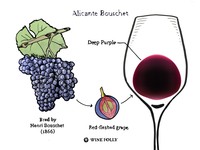Alicante Bouschet - A Really Red Grape
 Alicante Bouschet (“alla kahn tay boo shea”) is one of only a very few varieties of teinturier grapes of the Vitis vinifera species that have both red flesh and red skin. This grape originated in France as a cross between Petit Bouschet (also a teinturier grape) and the better-known Grenache or Garnacha as it is called in Spain. The grape is named after Henri Bouschet the Frenchman who first generated the cross in 1866.
Alicante Bouschet (“alla kahn tay boo shea”) is one of only a very few varieties of teinturier grapes of the Vitis vinifera species that have both red flesh and red skin. This grape originated in France as a cross between Petit Bouschet (also a teinturier grape) and the better-known Grenache or Garnacha as it is called in Spain. The grape is named after Henri Bouschet the Frenchman who first generated the cross in 1866.
Alicante Bouschet was the topic of a previous Carl’s Corner, June-2019, and because the McPherson Alicante Bouschet Block Series bottling has been on the Texas Wine Collective tasting menu recently it reminded me it might be time to highlight this variety once again. Grapes for the McPherson Alicante were grown in the special Newsom Block of the large Lahey Vineyard near Brownfield, TX, in Terry County. Several wineries in Texas are now producing Alicante bottlings and/or using the grape in red wine blends.
The dark color of Alicante Bouschet provides winemakers with some advantages which can be important here in Texas. Several grape varieties, Grenache, for example, are color limited in Texas, so blending Alicante can not only help darken the color but provide a richer flavor profile. Thus, Alicante has long been used as a blending grape in many regions, including California, France, and Portugal. Another advantage relates to helping reduce extended skin contact for typical red grapes. Since the color for most red grapes like Cabernet Sauvignon or Merlot is in the skins, extended contact (maceration) of the originally colorless juice is required to extract suitable color from the skins. This long period of maceration may also cause extraction of too much tannin from the skins and seeds, giving the wine an astringent, bitter character that not everyone may appreciate. Blending Alicante early in the winemaking process can help to reduce maceration times and achieve desired color concentration with reduced tannin levels.
Alicante Bouschet can give high fruit yields, and was thus a very popular variety in France following the Phylloxera epidemic that devastated most European vineyards in the late 1800’s. The grape is also relatively easy to maintain in the vineyard with a thick skin that helps to resist many pests and diseases. Today, Alicante Bouschet has significant plantings in the French regions of Languedoc, Provence, and Cognac (where it is used to make wine that is distilled to produce brandy). Elsewhere in Europe, Alicante is grown extensively in southern Portugal, particularly in the large Alentejo region, where its wines are prized for their dark color and intense flavor.
The history of Alicante Bouschet in the U.S. is quite interesting. The grape was extensively planted in California before and during Prohibition (1920-1933) and the fruit was shipped in railcars to the East Coast for use by home winemakers who were allowed to make 200 gallons of wine per year for personal consumption. Alicante was also a key variety used by producers of sacramental wines. Alicante has a thick skin that helped resist rot and damage during transportation to East Coast distribution centers like the rail hub in Chicago, the produce docks in Philadelphia, and New York’s Pennsylvania Station. Adding further value to these grapes, the dark red color in Alicante wines allowed significant dilution to stretch supply without giving away too much color.
A Wikipedia reference indicates that during one New York City auction in 1928, 225 railcar loads of grapes were purchased by a single buyer for further distribution. This was enough fruit to make about 2 million gallons of wine (833,333 cases). Does this make you, like me, a bit suspicious that perhaps organized crime may have been involved with plans for some serious bootlegging? LOL It has been speculated that a first wine was made from the dark raspberry-colored juice and then a second wine of lesser quality was made by adding water, sugar, and yeast to the leftover dark skins and seeds. One can imagine this second wine became a staple in many big city speakeasy bars.
Alicante Bouschet is still grown in many wine regions with a focus on its dense color and concentrated flavor profile. Alicante is used in Chile and several areas in California to blend with grapes like Cabernet Sauvignon to make more concentrated, deeply colored reds. Alicante Bouschet plantings are also known in warm climate regions like Algeria, Israel, parts of Italy, and now Texas.
